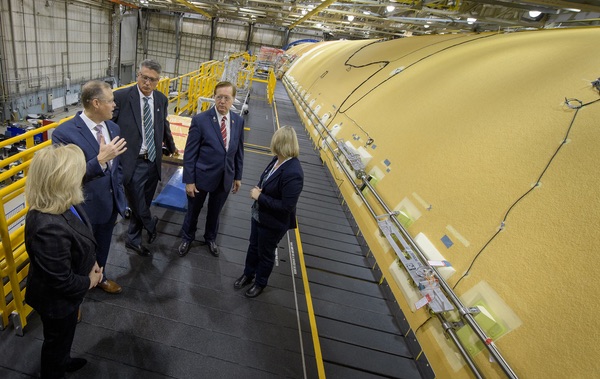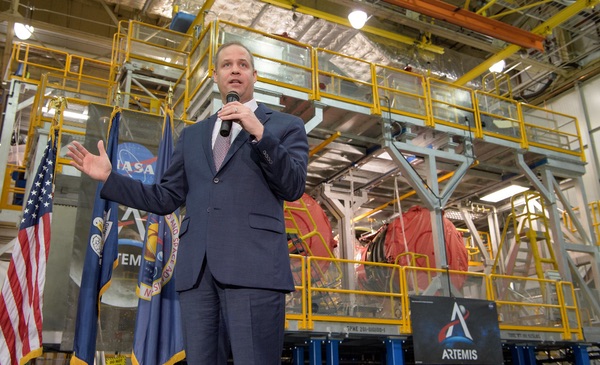A work in progressby Jeff Foust
|
| “Think of it as NASA’s Christmas present to America,” Bridenstine said of the impending shipment of the SLS core stage from Michoud. |
Last Monday, NASA invited industry and government officials, and the media, to an “Artemis Day” event at the Michoud Assembly Facility in New Orleans. The event was designed to celebrate the completion of the core stage for the first Space Launch System rocket. The stage itself, though, was hard to see, surrounding by scaffolding to give technicians access to the stage as they carried out some final tests. What stood out the most were the four RS-25 engines at its base, thanks in part to bright red covers over them.
The core stage, and its scaffolding, served as the backdrop for the main event, a speech by NASA administrator Jim Bridenstine. He thanked the various guests, from local officials to members of Congress, “for being here on this very important day when we get to announce core stage complete.”
The presence of the scaffolding and the technicians working on the stage—there were sounds of machinery in the background even as Bridenstine spoke—suggested the core stage wasn’t quite complete, but close enough, at least, for NASA to celebrate. By around the end of the month, he said, the stage would be moved out of the giant assembly building at Michoud and onto a barge called Pegasus, which will transport it to the nearby Stennis Space Center in Mississippi for testing.
“Think of it as NASA’s Christmas present to America,” Bridenstine said in his speech.
It might be a slightly late Christmas present, though. The agency hasn’t set a date for that move from Michoud to Stennis, which might slip to early January. “Once we finish the functional testing, then we’ll start to prep for ship,” John Honeycutt, NASA SLS program manager, said in a later panel discussion at the event. “I do think that we’ve got a good chance of rolling onto the barge by the end of the year, and if not, it will be shortly thereafter.”
Once at Stennis, the core stage will undergo a series of tests, culminating with the “Green Run,” where the stage’s four engines will fire for eight minutes. “It’s an opportunity for us to really learn all about the core stage and how it performs before we ever get into flight,” Honeycutt said.
The Green Run test is unlikely to take place before the middle of next year, which led one person to ask Honeycutt during that panel discussion why it takes so long. He explained that there will be a series of tests leading up to the Green Run, including a “wet dress rehearsal” where the stage will be fueled but its engines not fired. “It’s a big, complex, system-level test,” he said of the overall effort.
Another factor in the length of the core stage’s stay at Stennis is a change in how the stage was assembled. Problems with the engine section forced NASA earlier this year to move from vertical integration, where one section of the stage was stacked on top another, to a horizontal integration that allowed for other segments of the stage to be integrated while technicians dealt with the complexities of the engine section.
| “We’ve had the date out there that we would launch Artemis 1 in 2021,” Bridenstine said. “It’s looking like 2021 might be in the cards for the first Artemis mission.” |
That approach did have some drawbacks, Honeycutt said. “There’s some amount of work to make some pretty significant connections inside the engine section, to connect those feed lines to the engines, when we go vertical,” he said. That work, he said, will be done once the stage is placed into the vertical position on the test stand at Stennis. (It’s not clear how that will be handled on future SLS core stages: Boeing vice president Jim Chilton said in an interview that the second SLS core stage will also be horizontally integrated, after which the company will decide whether to go back to the original vertical integration approach.)
The biggest schedule uncertainty, though, extends to the date when that core stage, attached to its two five-segment solid rocket boosters, upper stage, and Orion spacecraft, will lift off on the Artemis 1 mission. NASA’s last official date for that mission was late 2020, but it had become increasingly clear that the launch would slip to some time in 2021.
Bridenstine all but confirmed that slip at the Artemis Day event. The decision on a new launch date will be made in the next few months by Doug Loverro, who started work as the new associate administrator for human exploration and operations at the beginning of the month. “I want to make sure that, before we put a hard date on it, I give our new associate administrator time for him to do his own assessment,” Bridenstine said. “The goal here ultimately is to be realistic about our projections.”
Bridenstine, though, seemed to acknowledge that launch won’t take place in 2020. “We’ve had the date out there that we would launch Artemis 1 in 2021,” he said, a date he reiterated at a later social media panel discussion at the event. “It’s looking like 2021 might be in the cards for the first Artemis mission.”
That was news, it seemed, for one NASA manager. “I’m still hanging on with my fingernails to a November 2020 date on Artemis 1,” said Mark Kirasich, NASA Orion program manager, in an interview during the event. The Orion spacecraft that will fly that mission was recently shipped to NASA’s Plum Brook Station in Ohio, where it’s beginning a thermal vacuum test that will last more than two months.
That November 2020 date, Kirasich said, was technically feasible, but with “zero margin” in the schedule, “which is why the administrator likely announced 2021 today.”
 Bridenstine shows off the core stage from the vantage point of the upper levels of scaffolding to an audience that included Rep. Randy Weber (R-TX), second from right. (credit: NASA/Bill Ingalls) |
A slip in Artemis 1 to 2021 raises questions about NASA’s ability to get humans to the Moon by 2024 on Artemis 3, but Bridenstine said a delay in Artemis 1 doesn’t push out future launches in a linear fashion.
“A lot of people seem to believe that if Artemis 1 slips, then Artemis 3 isn’t going to make it in 2024. That is simply not accurate,” he said in an interview last Tuesday in Washington as part of the annual SpaceNews awards luncheon. “Artemis 2 is an independent mission from Artemis 1. If we needed to, we could push Artemis 1 back and still make Artemis 2 go on schedule to make Artemis 3 successful.” Artemis 2 is scheduled for some time in 2022.
There is an increasing focus on those follow-on missions. Hardware is already being manufactured, both for Orion and SLS, for Artemis 2 and 3. In September, NASA announced a long-term production contract with Lockheed Martin for as many as 12 Orion spacecraft, starting with the Orion for Artemis 3.
A month later, NASA said it was starting negotiations with Boeing on a similar long-term production contract for SLS. That would include up to ten SLS core stages, beginning with Artemis 3 (NASA has already authorized initial funding to begin work on the Artemis 3 SLS.)
Those negotiations are ongoing. “I personally don’t think we’re that far apart,” Boeing’s Chilton said. “It’s actually going pretty fast.”
| NASA said in its October announcement that the EUS would start being used on the fourth SLS mission. Yet, in a press release last week, Boeing said the EUS would be introduced “for the third moon mission” in 2024, aka Artemis 3. |
One key issue is how much those future SLS rockets will cost. Bridenstine rejected claims, including in an Office and Management Budget letter to Congress in October, that the vehicle costs more than $2 billion each today, but said a goal is to reduce the price through a bulk buy.
“I would also say the number comes way down when you buy more than one or two,” he said in a town hall meeting with agency employees December 3 to introduce them to Loverro. “I think at the end, we’re going to be at the $800 million to $900 million range. I don’t know, honestly,” because the negotiations are ongoing.
The Artemis Day event disclosed some other differences between NASA and Boeing regarding SLS production. One involves ramping up the production rate. Some in Congress have pushed to get the production rate to two vehicles a year by 2024, allowing one SLS vehicle to be used for the Artemis 3 Orion mission while another could launch an entire lunar lander—something Boeing has proposed (see “Seeking a bigger role for a big rocket,” The Space Review, November 18, 2019).
Chilton said he doesn’t see many difficulties to increasing the production rate, arguing that, despite the difficulties with the first SLS core stage, new ones could be built at a rate of about one every eight months. “So we’re not that far off it,” he said of a two-per-year production rate.
Bridenstine, though, didn’t share that optimism about quickly increasing SLS production. “Nobody has presented me a plan that says that that’s happening, but certainly I would fully support it if they could make it happen,” he told reporters at the event when asked if getting to two vehicles per year by 2024 was feasible. “I’m not counting on that for 2024, quite frankly.”
There’s also a disconnect between NASA and Boeing about when to introduce the Exploration Upper Stage (EUS), a more powerful upper stage that will replace the Interim Cryogenic Propulsion Stage, based on the Delta IV upper stage, that will initially be used on the SLS. Moving to the EUS, creating what’s known as the Block 1B version of SLS, would increase its payload performance, allowing it to carry additional payloads on Orion missions.
While the EUS originally was going to be introduced on the second SLS mission, NASA said in its October announcement of a long-term production contract with Boeing that the EUS would instead start being used on the fourth SLS mission. Yet, in a press release last week, Boeing said the EUS would be introduced “for the third moon mission” in 2024, aka Artemis 3.
“Our target is ’24,” Chilton said of having the EUS ready. “The Artemis 3, 4 time frame.”
Bridenstine didn’t directly address that timeframe at the Artemis Day event, although he later told the Washington Post that the EUS is “just not going to be ready” for 2024. At the event, he appeared focused on just getting the initial Block 1 SLS flying and using that to enable a return to the Moon in 2024, with commercial launch vehicles handling other payloads, like elements of the lunar Gateway and lunar lander modules.
“For 2024 we need to be focused on getting that Artemis 3 SLS complete, and using other rockets to do payload deliveries and that kind of thing apart from the SLS itself,” Bridenstine said. But first, there’s the small matter of getting that first SLS complete, and launched.
Note: we are temporarily moderating all comments submitted to deal with a surge in spam.
